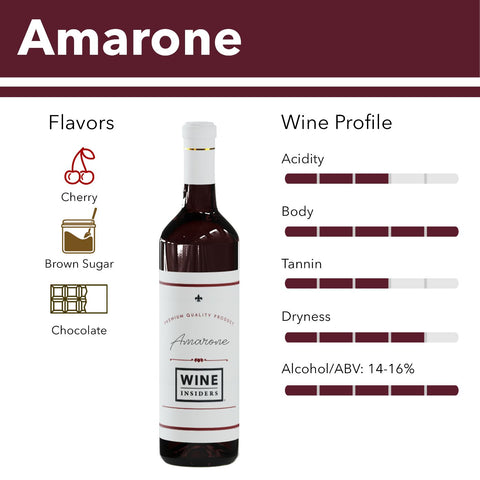Amarone
"Amarone" means "the great bitter" in reference to the wine's dryness.
"Amarone" means "the great bitter" in reference to the wine's dryness.

Ah-mah-rone-eh
Parents & Origin: Corvina, Rondinella (Northern Italy)
Grape: Small, black skin, partially dried
Flavors: Black cherry, brown sugar, chocolate
Notable Regions: Valpolicella, Verona, Italy
Sweetness: Dry
Body: Full
Tannins: Medium
Acidity: Medium
ABV: 14-16%

Amarone (officially Amarone della Valpolicella) is a unique and highly sought after red wine that often comes alongside a hefty price tag. The wine is produced in the Valpolicella viticultural area in the Verona province of northern Italy, an area that is second only to Chianti in total DOC wine production.
The name “Amarone” was not recorded publicly until 1953, with some crediting the term to a cellarmaster who tasted the wine in 1936. However, winemaking in the style of Amarone has been prevalent in Valpolicella since the time of the ancient Greeks, with the technique of using partially dried grapes to concentrate sugar emerging around this time.
For most of winemaking history in Valpolicella, sweet wines were the product of the partial drying process. In fact, the region became predominantly known for this style of wine, with the sweeter, related “Recioto della Valpolicella” becoming a favored variety. Some say that Amarone della Valpolicella was originally just Recioto that had fermented for too long, thus becoming more dry.
Regardless of its exact origin, Amarone quickly grew in popularity in the 20th century. It was granted DOC classification in 1990, followed by DOCG recognition for both Amarone and Recioto in 2009. Today it is known as a somewhat eclectic wine, often with a high price tag and high alcohol content that can turn away those unfamiliar with this rich, red wine. If you get your hands on a bottle, however, it’s sure to impress and serve as a great addition to your collection.
Interesting Fact: The name “Amarone” literally means “the great bitter,” referencing the wine’s dryness in comparison to Recioto. Local legend states that cellarmaster Adelino Lucchese exclaimed the phrase upon tasting the wine for the first time in 1936.
Due to its intense flavor profile and high acidity, Amarone can stand up to a wide variety of foods:
Amarone can be drunk on its own simply to appreciate the unique flavors, but when pairing with food, it works best with rich meat dishes such as beef, lamb, or even duck. Traditional Venetian pastas and strong cheeses can also complement Amarone quite well.
This wine is far too intense for fish or salads—stick to rich meats and complementary sauces to bring out the best in Amarone.

Amarone’s unique flavors come from three main areas: the grape drying process, the fermentation process, and an aging period. After harvesting, the grapes are laid out on straw mats for as many as 120 days, with water content needing to be reduced by at least 40% under DOCG regulations. The fermentation process usually takes place at lower temperatures than other wines, thus requiring more time to complete.
Finally, an aging period in oak or chestnut barrels takes place for at least two years. This delicate process is very important as any mistake could lead to disaster for the entire yield. When successful, however, Amarone is a bold yet low-tannin wine with luscious aromas of cherry liqueur, black fig, carob, cinnamon and plum sauce, with flavors of black cherry, brown sugar, and chocolate.
There is a divide among Amarone producers, with some favoring the purely traditional “appassimento method” and others opting to use modern winemaking techniques. The main distinctions between the two styles are that appassimento wines use hand-picked grapes, sun drying, and neutral oak barrels, whereas new-school Amarone uses modern equipment, controlled temperatures, and new oak.
The resulting wines result in a more age-friendly wine from the appassimento method (best consumed around 10-20 years old), whereas the modern wine can be drunk younger (about 4-8 years) but will not age quite as well in the bottle.
Amarone della Valpolicella is classed under the Denominazione di Origine Controllata e Garantita (DOCG) system, the highest classification of wine in Italy. This means that Amarone producers must follow a strict set of rules before releasing their wines:
Variations within these DOCG requirements can give clues to flavor variations within the wine. For example, wines with high percentages of grapes other than Corvina, Corvinone, or Rondinella are likely more modern and can be drunk immediately. In contrast, take note of the vintage on a bottle of Riserva - even if it’s already old, it might be worth holding onto for a decade or more to bring out its best flavors.
An eclectic and almost paradoxical wine, Amarone della Valpolicella entices with its bold and dry body, light tannins, and rich fruit and chocolate flavors. With a delicate and arduous winemaking process, Amarone has earned its high price tag, as a great bottle requires everything from perfectly dried grapes, ideal fermentation temperatures, and precise oak aging. Thankfully, with a little money to spend, you can add a bottle of Amarone to your wine collection and give your guests a taste of Italian luxury. Whether consumed on its own or paired with a rich meat dish, Amarone della Valpolicella is sure to impress.
There's nothing in your cart yet.
Shop All Wines